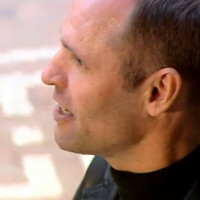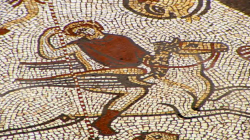Lullingstone Roman Villa
Gnosticism
Britain AD: King Arthur’s Britain

Dominic Perring
At Lullingstone Roman villa the discovery of a converted chapel was evidence Christianity had been practised. Within the mosaics Dominic Perring
has found a sign that the people here were dealing in an unusual Christian cult called Gnosticism.
Dominic Perring “The fourth century is a period of vigorous intellectual ferment. Whereas today we believe science is leading us forward, then it
was philosophy. People were trying to escape the mortal condition. The prison of our world. To escape, it was about knowing the secrets, it was
about knowing how to move into a higher plane of existence. Knowledge was part of that. Knowledge of images, of mythology, of philosophy,
knowledge of Christ. But also, secret knowledge.”
Hidden in the mosaics, Dominic has found gnostic images blending classical myths with Christian ideas about immortality. This strange fusion of
beliefs was at the heart of the Gnostic cult. It may have become a symbol of Romano-British culture.
Dominic Perring “Bellerophon is slaying a monster. He’s riding winged Pegasus. The message is good slaying evil and also the attempt to reach life
immortal. It certainly was a set of beliefs which lent itself to urban, aristocratic, elite society and Villa society. These were people who were
able to engage in these arcane discussions.”

Bellerophon on Pegasus
Such independent thinking could not be tolerated by the Empire and in 380 the Emperor denounced Gnosticism as heresy.
Dominic Perring “The Emperor establishes edicts against heretics. You’re allowed to exile people, confiscate their lands. How does one stop heretics
being heretics? Stop them baptising. If a bishop can’t baptise a flock, you don’t increase the flock’s size. So destruction of baptismal fonts is one
way of doing it. We’ve got archaeological evidence of damaged lead tanks, some clearly used for baptism, which are being cut into pieces and thrown
down wells.”
The crumpled baptism tank I’d seen was just one of many Christian items which had been deliberately destroyed or buried in this area.
Dominic Perring “We have church plate, baptismal spoons, the chalice used in the Eucharist, buried in these silver hordes. People are
decommissioning these items.”
Whoever buried this collection of silver must have felt anger and resentment.
Because their property, their beliefs, their very identity were under attack. By the time this treasure was buried,
Rome had lost the hearts and minds of the native Britons.

Buried Treasure
Having invited the Romans in, absorbed and digested the various influences of the classical world, Britain turned its back on Rome and looked to
an independent future. The end of Roman administration was a new beginning for the people of Britain. Three and a half centuries after the Romans
destroyed it, the magnificent hillfort of South Cadbury was re-occupied. It has long been imagined that the figure who led this resurgence was
King Arthur.
Guy de la Bedoyere “Arthur is a product of generations and how they see themselves. Arthur was created largely by mediaeval romantic
historians who wanted to create a pseudo-chronology of events after the Roman invasions. The trouble is it’s loosely threaded together with
pieces of genuine evidence. It depends how literally you choose to take that. I rather suspect Arthur is a metaphor, a symbol, of the petty
tribal chieftain who would have taken power in a region after Roman power collapsed. A man who could hold his people together.”
This valiant King embodies a brave new world, in which the descendants of Roman Britain began to build an independent future. And yet
for centuries, we have shrouded this exciting time under a veil of mystery and labelled it the Dark Ages.


